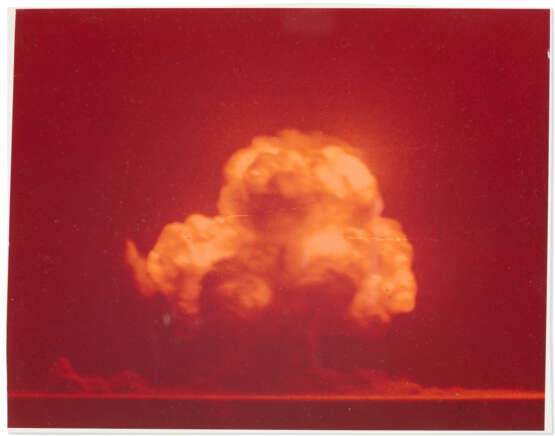ID 1360936
Lot 222 | The only color image of the Trinity Test
Valeur estimée
$ 7 000 – 10 000
180 x 228mm, stamped "LOS ALAMOS PHOTO LABORATORY" with the negative number "CN70 - 2103" stamped on verso (irregularly trimmed at margins, two light horizontal fold creases). Simply framed with a note written on memo stationery affixed to verso "Jim—I hope this is what you had in mind. I got it from Los Alamos, and although not labeled, it is the Trinity Shot, and is the only existing color shot of the test, taken at Alamogordo July 16, 1945. Ginny."
The dawn of the nuclear age: the only color photograph taken of the Trinity Test. A rare color print of Jack Aeby's iconic image of the first uncontrolled nuclear chain reaction that occurred in the early morning hours of 16 July 1945.*
The photographer, Jack Aeby, came to Los Alamos by sheer chance. A graduate of the University of Nebraska, he was driving with a friend to California when they stopped at his brother’s house in Santa Fe, New Mexico for the night. Aeby’s cousin, who was also staying there, said he had just applied for, “an unknown job in the hills above Santa Fe … And he gave me an application.” Within a week, he had a job developing technical equipment to identify fissionable material, working with Emilio Segré primarily. At the time of the Trinity test in July 1945, Aeby related, that he ”wasn’t a photographer, that wasn’t my job, except I did carry a camera ever since high school almost daily and of course I couldn’t anywhere around Los Alamos. But Segrè decided he wanted a photo history of what the group was doing, so he got me appointed official photographer for the group and I used most of the time his camera, but I took mine so I could carry it all the time—he was using his own. Anyway, but when we went to the Trinity site for these ideas he negotiated with the Director and with the security services—got my official appointment as a photographer and one of the few people who had a camera at Trinity.”
Aeby managed to secure 100-foot reel of Agfa color motion-picture film, and he spent much of the day photographing the preparatory work of his team. But by nightfall, he realized he had only four frames left. Just before the test, stationed 6,000 yards northwest of ground zero, he turned his chair backwards “and sat in it using that as a tripod, aimed the camera at the detonation point … I opened the shutter wide—the full way, full stop—and put the shutter on bulb and held it open.” When the flash appeared, he “released the shutter, it closed, I cranked the exposure down to where it was reasonable, about 1,000 per second, and fired the other three shots in rapid succession. The middle one, by luck, turned out to be just about the right exposure” Word of his feat spread quickly, and images were requested before he was even able to develop the film. “And somehow the theoretical division got wind of that and they confiscated the photo for a time. And they actually did one of the first yield measurements by measuring the width of the fireball and estimated time of when that was made and they could back calculate something resembling a good estimate of the yield.” Following the attacks on Hiroshima and Nagasaki, Aeby’s photo was published widely, first under the mistaken credit of the U.S. Army. It was only later that Aeby was given credit for his feat.
The correct orientation. This photograph appears to be the one of the few examples where the image was not reversed. Aeby’s team at the Trinity test was stationed on the opposite side of ground zero from the main observation post where the official images of the explosion were made. Thus the majority of the reprints of Aeby’s photograph have been reversed to match the profile captured in all the other known images of the Trinity test.
_________
* Although some color motion picture footage was taken, it was of such a poor quality as not to be usable, and the film has since deteriorated. All other images, both still and motion pictures, were taken in black and white.
| Lieu d'origine: | Etats-Unis |
|---|---|
| Catégorie maison de vente aux enchères: | Tous les autres types d'objets |
| Lieu d'origine: | Etats-Unis |
|---|---|
| Catégorie maison de vente aux enchères: | Tous les autres types d'objets |
| Adresse de l'enchère |
CHRISTIE'S 20 Rockefeller Plaza 10020 New York Etats-Unis | ||||||||||||||
|---|---|---|---|---|---|---|---|---|---|---|---|---|---|---|---|
| Aperçu |
| ||||||||||||||
| Téléphone | +1 212 636 2000 | ||||||||||||||
| Fax | +1 212 636 4930 | ||||||||||||||
| Conditions d'utilisation | Conditions d'utilisation | ||||||||||||||
| transport |
Service postal Service de messagerie ramassage par vous-même | ||||||||||||||
| Modes de paiement |
Virement bancaire | ||||||||||||||
| Heures d'ouverture | Heures d'ouverture
|



